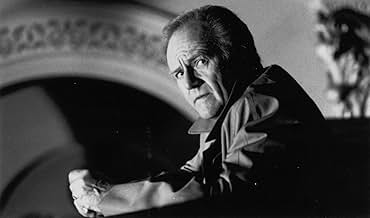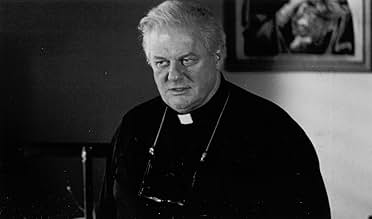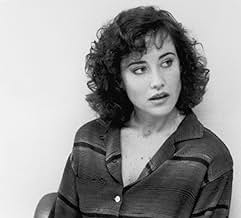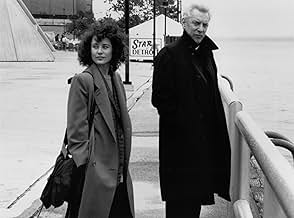IMDb RATING
5.9/10
1.9K
YOUR RATING
A priest is put in a dilemma when the serial killer who has been murdering priests and nuns confesses to him.A priest is put in a dilemma when the serial killer who has been murdering priests and nuns confesses to him.A priest is put in a dilemma when the serial killer who has been murdering priests and nuns confesses to him.
- Director
- Writers
- Stars
- Awards
- 2 wins total
- Director
- Writers
- All cast & crew
- Production, box office & more at IMDbPro
Featured reviews
Is this a giallo? A neo-noir? A detective story? Let's not play with labels. Let's just see it for what it is — a whodunit where priests and nuns are the victims of a serial killer who leaves a black rosary on their dead bodies.
Directed by Fred Walton (When a Stranger Calls) and adapted by Elmore Leonard, this is a dark, rough take on William X. Kienzie's novel (Kienzie left the Catholc priesthood in 1974 after 20 years due to the Church's refusal to remarry divorced people). This may have been the only movie concerning the detective skills of Father Robert Koesler (Donald Sutherland), but the character appeared in twenty three more novels from Kienzie.
The character is a progressive priest — even falling for a reporter, Pat Lennon (Belinda Bauer, RoboCop 2, Flashdance). He serves with Father Ted Nabors (Charles Durning, Tootsie), who is the exact opposite — a racist throwback to pre-Vatican 2 who follows the Church to the letter of the law.
The central dilemma of the film? The killer confesses to Koesler, who can't do anything about it, thanks to the Church's Seal of Confession. But what if other lives — maybe even his own — are in danger?
The film was shot on location at Detroit's Holy Redeemer Parish, and if you look hard enough, you'll see an uncredited Jack White — years before The White Stripes — as an altar boy. That feels like it should be an urban legend, but it is true.
The film has what some describe as a leaden pace. There are some great moments in it, such as when Koesler hears the killer in a cemetery and the ending, where the real killer is revealed. I'm always debating with myself whether or not to spoil the ending. It's a thirty year old movie, but I feel weird doing so here. Must be the Catholic in me.
Read more at bandsaboutmovies.com/2017/08/16/the-rosary-murders-1987/
Directed by Fred Walton (When a Stranger Calls) and adapted by Elmore Leonard, this is a dark, rough take on William X. Kienzie's novel (Kienzie left the Catholc priesthood in 1974 after 20 years due to the Church's refusal to remarry divorced people). This may have been the only movie concerning the detective skills of Father Robert Koesler (Donald Sutherland), but the character appeared in twenty three more novels from Kienzie.
The character is a progressive priest — even falling for a reporter, Pat Lennon (Belinda Bauer, RoboCop 2, Flashdance). He serves with Father Ted Nabors (Charles Durning, Tootsie), who is the exact opposite — a racist throwback to pre-Vatican 2 who follows the Church to the letter of the law.
The central dilemma of the film? The killer confesses to Koesler, who can't do anything about it, thanks to the Church's Seal of Confession. But what if other lives — maybe even his own — are in danger?
The film was shot on location at Detroit's Holy Redeemer Parish, and if you look hard enough, you'll see an uncredited Jack White — years before The White Stripes — as an altar boy. That feels like it should be an urban legend, but it is true.
The film has what some describe as a leaden pace. There are some great moments in it, such as when Koesler hears the killer in a cemetery and the ending, where the real killer is revealed. I'm always debating with myself whether or not to spoil the ending. It's a thirty year old movie, but I feel weird doing so here. Must be the Catholic in me.
Read more at bandsaboutmovies.com/2017/08/16/the-rosary-murders-1987/
Donald Sutherland is a Detroit priest who hears the confession of a serial killer with a grudge against the clergy, and is later forced by the ethics of his vocation to (reluctantly) hunt down the murderer himself, unearthing a spine-chilling string of motivation behind each new death. It could have been just another routine shocker, but a clever script and some unusually taciturn direction turns the otherwise familiar material into a modest but intriguing whodunit (actually more a 'whydunit') set against the rituals and mysteries of the Catholic Church, always a reliable source of guilt and intrigue. The steady accumulation of clues and evidence is interrupted only by an unsurprising (and unnecessary) romantic subplot, which happily compromises neither the mystery itself nor Sutherland's oath of celibacy.
Though not as riveting as its premise will have you believe, The Rosary Murders still manages to deliver moments of tension & suspense within a monotonously executed drama and is anchored by Donald Sutherland's measured performance as a conflicted priest. A run-of-the-mill effort at best when it comes to direction, the story is undone by its long runtime, an unnecessary subplot that goes nowhere & more but the mood & build-up before the serial killings is done well and the dilemma our protagonist faces is rendered with sincerity, along with the conflicted interpretation of Church law & teachings. However, the picture as a whole needed a tightly-edited plot to keep things interesting throughout and carries the look n feel of a TV film in more ways than one.
I like religious horror and giallos. For example one of my favorite horror films is Alice Sweet Alice, I think The Exorcist is a well-written drama, and I lean towards the Italian films with spiritual or religious imagery. The Rosary Murders deals with a lot of complex issues in the Catholic church, someone might argue the plot of this film is absurd, but it's not. A priest cannot tell on a child rapist or a serial killer even if they confess. One of the reasons I am giving this flick a solid six is because it attempted to confront these kinds of issues head-on, as well as other problems like overly focusing on sexuality in the American conservative churches to the point of insanity, and the mandatory celibacy of priests.
But to see Donald Sutherland in this film a scant fifteen years after the epic supernatural giallo, Don't Look Now, is a little sad. The Rosary Murders would have been so much better handled by a director with a better eye, who actually understood lighting and atmosphere and editing techniques. Instead, this movie looks like it could have been made for tv, and I consider it a stylistic flaw when handling this kind of subject matter. No one wants to watch a movie about religious murders that looks like an episode of Hill Street Blues.
But to see Donald Sutherland in this film a scant fifteen years after the epic supernatural giallo, Don't Look Now, is a little sad. The Rosary Murders would have been so much better handled by a director with a better eye, who actually understood lighting and atmosphere and editing techniques. Instead, this movie looks like it could have been made for tv, and I consider it a stylistic flaw when handling this kind of subject matter. No one wants to watch a movie about religious murders that looks like an episode of Hill Street Blues.
"The Rosary Murders" follows a Catholic parish in Detroit that is plagued by a series of brutal murders. One of the priests (Donald Sutherland) is joined by a journalist (Belinda Bauer) attempting to cover the story; both aim to stop the killer before he dispatches more nuns, monks, and members of the Holy Order.
This is a downbeat and gloomy affair from Fred Walton, who, the year prior, directed the playful, joke-filled slasher "April Fool's Day." "The Rosary Murders" is more a return to Walton's style as seen in "When a Stranger Calls" (1979) in that it is a much more austere, dour take on the genre. This film gives no reprieve, and the subject matter is relentlessly grim. It has a similar taste to other Catholic-themed slasher films, such as "Alice, Sweet Alice" (1976), or even "The Exorcist III" (1990), both of which set a serial killer narrative against the stark backdrop of the Catholic Church. There is something inherently transfixing (and sinister) about this formula that evokes a creep factor that is hard to shake (especially if you were brought up Catholic). "The Rosary Murders" also has a late-'80s flair about it that at times feels redolent of a number of "Unsolved Mysteries" episodes.
What works best about the film perhaps is the atmosphere: the wintry Detroit setting only adds to the ambiance, and the gothic cathedral and parish buildings are moodily photographed throughout. Donald Sutherland gives a muted but solid performance as the central priest, while Charles Durning has a smaller part as one of Sutherland's superiors. Belinda Bauer is great as the spunky reporter and has good chemistry with Sutherland, but it is ultimately wasted as her character is given little to do before altogether disappearing for the last quarter of the film (which is one of its main faults). Another instance where the film falters is that it has an even-keeled tone from beginning to end that drains the proceedings of any high suspense; the identity and motive of the killer is also unveiled too early, leaving little surprises to be had, and where the film feels like it should reach a fever pitch, it simply doesn't.
All that being said, I still found "The Rosary Murders" absorbing and extremely watchable. It is a dour, gloomy affair that works better as a mood piece than it does a thriller or mystery. Its narrative issues aside, the shadowy halls of the parish and the chilly Detroit exteriors impress a somberness on the viewer that is unusually stirring. 7/10.
This is a downbeat and gloomy affair from Fred Walton, who, the year prior, directed the playful, joke-filled slasher "April Fool's Day." "The Rosary Murders" is more a return to Walton's style as seen in "When a Stranger Calls" (1979) in that it is a much more austere, dour take on the genre. This film gives no reprieve, and the subject matter is relentlessly grim. It has a similar taste to other Catholic-themed slasher films, such as "Alice, Sweet Alice" (1976), or even "The Exorcist III" (1990), both of which set a serial killer narrative against the stark backdrop of the Catholic Church. There is something inherently transfixing (and sinister) about this formula that evokes a creep factor that is hard to shake (especially if you were brought up Catholic). "The Rosary Murders" also has a late-'80s flair about it that at times feels redolent of a number of "Unsolved Mysteries" episodes.
What works best about the film perhaps is the atmosphere: the wintry Detroit setting only adds to the ambiance, and the gothic cathedral and parish buildings are moodily photographed throughout. Donald Sutherland gives a muted but solid performance as the central priest, while Charles Durning has a smaller part as one of Sutherland's superiors. Belinda Bauer is great as the spunky reporter and has good chemistry with Sutherland, but it is ultimately wasted as her character is given little to do before altogether disappearing for the last quarter of the film (which is one of its main faults). Another instance where the film falters is that it has an even-keeled tone from beginning to end that drains the proceedings of any high suspense; the identity and motive of the killer is also unveiled too early, leaving little surprises to be had, and where the film feels like it should reach a fever pitch, it simply doesn't.
All that being said, I still found "The Rosary Murders" absorbing and extremely watchable. It is a dour, gloomy affair that works better as a mood piece than it does a thriller or mystery. Its narrative issues aside, the shadowy halls of the parish and the chilly Detroit exteriors impress a somberness on the viewer that is unusually stirring. 7/10.
Did you know
- TriviaFuture musician Jack White appears as an altar boy, marking this as his film debut.
- GoofsA priest is called to the confessional from his quarters in the church. He walks across the altar to reach the confessional without genuflecting in front of the altar.
- Quotes
Father Edward Killeen: Break the seal of confession, and you destroy the Church.
Father Robert Koesler: People are going to die.
Father Edward Killeen: You're saving souls Bob, not lives.
- ConnectionsReferenced in Père et fille (2004)
- SoundtracksIN YOUR EYES
Recorded & Sung by Nancy Wood
Composed by Bobby Laurel
Lyrics by Bobby Laurel & Dennis Leahy
Based on an adaptation of the Third Symphony written by Johannes Brahms
- How long is The Rosary Murders?Powered by Alexa
Details
- Release date
- Country of origin
- Language
- Also known as
- The Rosary Murders
- Filming locations
- Dearborn, Michigan, USA(scenic overview of the industrial area)
- Production companies
- See more company credits at IMDbPro
Box office
- Gross US & Canada
- $1,730,337
- Gross worldwide
- $1,730,337
- Runtime1 hour 45 minutes
- Color
- Sound mix
- Aspect ratio
- 1.85 : 1
Contribute to this page
Suggest an edit or add missing content





























